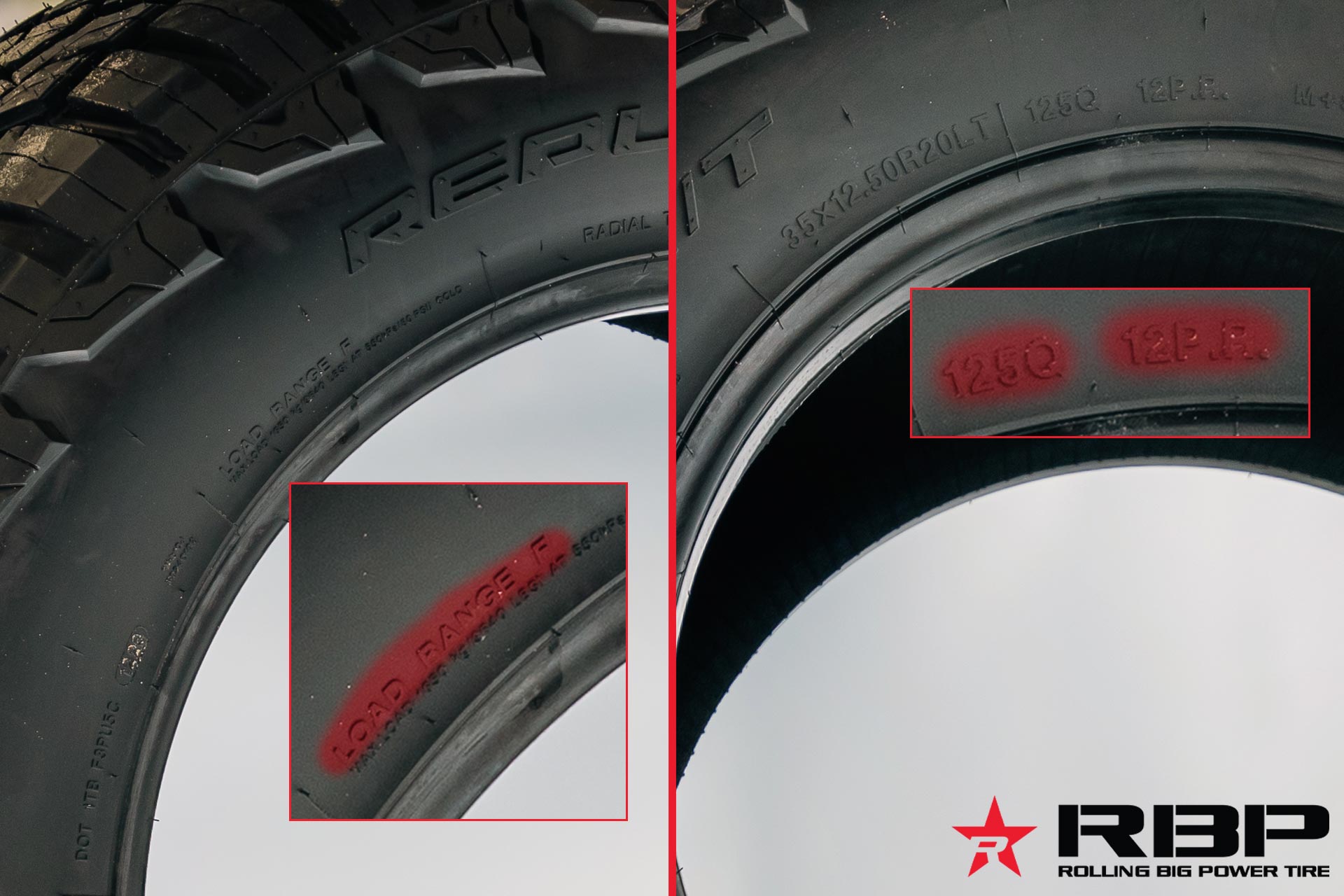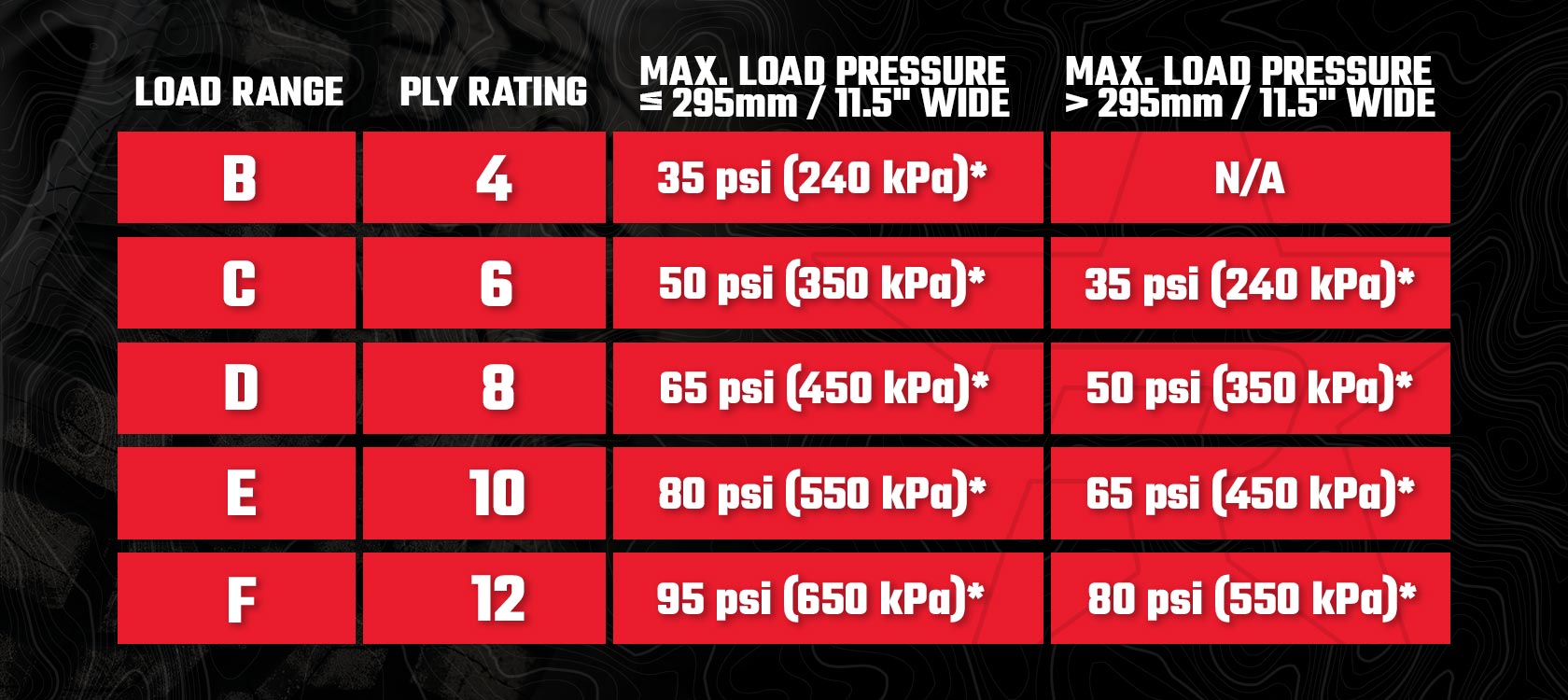When purchasing new tires for your truck, there are many factors to consider, such as performance characteristics. However, load rating is one of the most important attributes, especially for drivers who frequently tow or haul goods and materials.
Load rating is the maximum amount of weight that a tire can safely carry. Excessive loads can damage tires and shorten their lifespan. It is important to understand how to interpret load ratings when shopping for new truck tires to ensure your safety on the road, or off of it.
A tire load rating chart can help you determine which tire can handle the weight you will be placing on it. It is important to choose tires with a load rating that is appropriate for the weight of your truck and the amount of weight you will be carrying.
By understanding tire load ratings and using a tire load rating chart, you can ensure that you choose the right light truck tires for your needs and keep yourself safe on the road.
Have you ever heard of load range and load index? These are two of the many tire specifications that indicate how much weight a tire can safely carry. Load range is a letter designation, while load index is a number designation. The load range and load index of a tire must match the vehicle’s requirements in order to ensure safe operation.
Let’s take a closer look at each of these ratings to understand how they work.
Load range is a letter designation that indicates the maximum weight that a tire can safely carry at a certain PSI (air pressure). The most common load range letters for light trucks range from B to F, with B being the lowest load rating and F being the highest. For example, a tire with a load range of D can safely carry maximum load at 65 PSI.
Load index is a number designation that indicates the maximum weight that a tire can safely carry. The load index numbers range from 0 to 275. However, more commonly you will see the numbers range from 70 to 126 for light truck tires. The higher the load index number, the more weight the tire can carry. For example, a tire with a load index of 112 can safely carry up to 2,469 pounds.
Tire ply ratings indicate the number of layers of fabric that are used in the construction of a tire. The higher the ply rating, the stronger the tire. For example, a tire with a ply rating of 4 ply is stronger than a tire with a ply rating of 2 ply.
It is important to choose tires that have the correct load range, load index, and ply rating for your vehicle. Using tires with the wrong ratings can increase the risk of tire failure, which can lead to accidents.
To find out the correct tire ratings for your vehicle, consult your owner’s manual or contact your local tire dealer.
Every tire has load ratings marked on its sidewall. This also applies to standard sizing and flotation sizing, commonly found on mud-terrain tires. To learn more about how to read a sidewall, check out our guide.


*Some LT sizes have been designed with modified maximum load pressures. Always follow the maximum pressure and load indicated on the tire’s sidewall.
| Load Index |
Pounds | Kilograms | Load Index | Pounds | Kilograms | Load Index | Pounds | Kilograms |
|---|---|---|---|---|---|---|---|---|
| 70 | 739 | 335 | 89 |
1279 |
580 |
108 | 2205 | 1000 |
| 71 | 761 | 345 | 90 | 1323 | 600 | 109 | 2271 | 1030 |
| 72 | 783 | 355 | 91 | 1356 | 615 | 110 | 2337 | 1060 |
| 73 | 805 | 365 | 92 | 1389 | 630 | 111 | 2403 | 1090 |
| 74 | 827 | 375 | 93 | 1433 | 650 | 112 | 2469 | 1120 |
| 75 | 853 | 387 | 94 | 1477 | 670 | 113 | 2535 | 1150 |
| 76 | 882 | 400 | 95 | 1521 | 690 | 114 | 2601 | 1180 |
| 77 | 908 | 412 | 96 | 1565 | 710 | 115 | 2679 | 1215 |
| 78 | 937 | 425 | 97 | 1609 | 730 | 116 | 2756 | 1250 |
| 79 | 963 | 437 | 98 | 1653 | 750 | 117 | 2833 | 1285 |
| 80 | 992 | 450 | 99 | 1709 | 775 | 118 | 2910 | 1320 |
| 81 | 1019 | 462 | 100 | 1764 | 800 | 119 | 2998 | 1360 |
| 82 | 1047 | 475 | 101 | 1819 | 825 | 120 | 3086 | 1400 |
| 83 | 1074 | 487 | 102 | 1874 | 850 | 121 | 3197 | 1450 |
| 84 | 1102 | 500 | 103 | 1929 | 875 | 122 | 3307 | 1500 |
| 85 | 1135 | 515 | 104 | 1984 | 900 | 123 | 3417 | 1550 |
| 86 | 1168 | 530 | 105 | 2039 | 925 | 124 | 3527 | 1600 |
| 87 | 1201 | 545 | 106 | 2094 | 950 | 125 | 3638 | 1650 |
| 88 | 1235 | 560 | 107 | 2149 | 975 | 126 | 3748 | 1700 |
It is essential to consider load index and load range when shopping for new tires for your truck. As mentioned above, a tire that falls within the proper specifications on the load index and load range chart will be an overall safer tire that suits your needs. This is especially important if you tow or haul frequently and/or with heavy items.
Another aspect to consider is the weight of your truck with all of its off-road gear, such as traction boards, roof racks, and lightning equipment. Once you know what you need to carry, you can calculate the load index of all four tires to see if they can handle the weight. The worst-case scenario is a tire blowout due to improper load indexes. However, it is also probable that tires will need to be replaced more often due to premature tread wear.